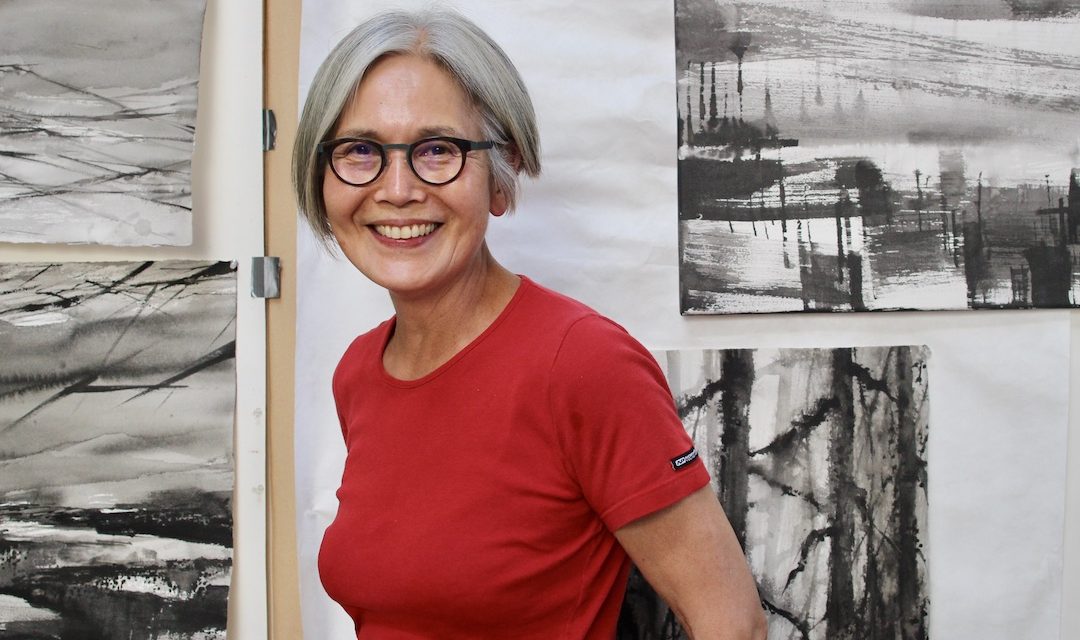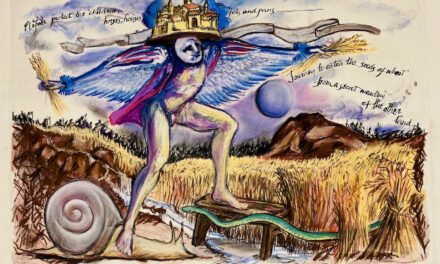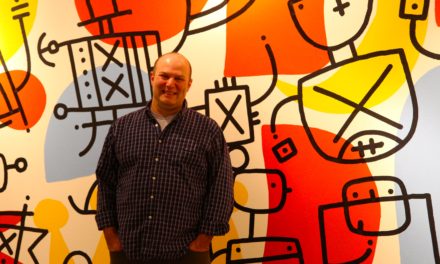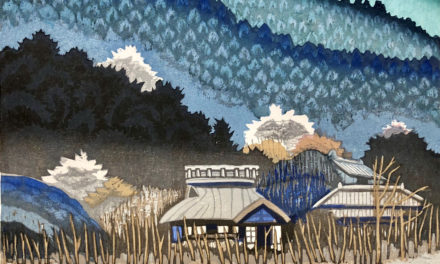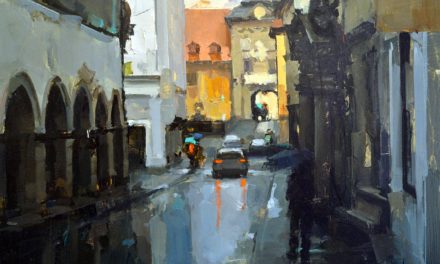(Above: As post-pandemic life regains some normalcy, Eugene artist Satoko Motouji has put her art on the walls of three local galleries and one new arts center; photos by Randi Bjornstad.)
By Randi Bjornstad
Like many other artists, Satoko Motouji’s life changed dramatically during the past year-plus of isolation and uncertainty during the height of the coronavirus pandemic.
“For the first few months, I didn’t know what to do at all, even about going to the grocery store,” Motouji mused during a recent interview at her studio in Eugene’s Whiteaker neighborhood. “In about April or May of 2020, I started doing some watercolors, but that wasn’t really working, and suddenly it all changed, and I began doing mostly black-and-white — with feelings of thunder, slipping, blowing.”
The pandemic probably wasn’t the only reason for the unease that led to her change in style, Motouji surmised, because 2020 was such a difficult year all the way around.
“The virus was a big part, but then in the summer came all of the wildfires and all that destruction,” she recalled. “And even after all that came the election, which meant even more negative thoughts and emotions that also affected my painting.”
Frankly, Motouji acknowledged, “I’m cranky when I am not able to paint, and then I just don’t like myself, which makes it even worse. When I paint regularly, I feel much better about myself.”
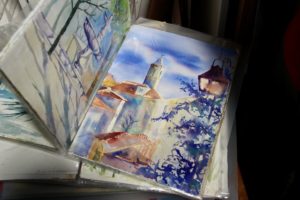
Vivid colors of faraway places often gave way to somber black-and-white paintings during Motouji’s pandemic work.
She’s apparently feeling quite a bit better now. Motouji’s work has appeared on the walls of three local galleries within the past several weeks, starting with a just-ended show, Be Here Now, at the Maude Kerns Art Center at 1910 E. 15th Ave. in Eugene, in which she exhibited two Sumi ink drawings — Essentials #29 and Forest #1 — that still can be seen on the website at mkartcenter.org.
She also has four pieces in Summer: Reflection of the Season, an exhibit at the White Lotus Gallery at 767 Willamette St. in Eugene, where Motouji is a represented artist. That show runs through July and also can be viewed online, at wlotus.com.
Most recently, the Karin Clarke Gallery just opened a new display featuring art by the eight award-winners of last summer’s 2020 Eugene Biennial juried show. Motouji was one of the eight, securing her a spot in the 2021 follow-up show, titled Eugene Biennial Award Winners: One Year Later. Her contribution there includes five large Sumi ink drawings and can be viewed along with the other winners’ work at the gallery at 760 Willamette St. through Aug. 21 and also online at karinclarkegallery.com.
Then there’s Motouji’s much different artwork at the new Midtown Art Center at 1590 Willamette St. near downtown Eugene. The new building, owned by Eugene Ballet and also home to several other local arts groups as tenants, opened in January.
In 2018, Eugene Ballet presented an all-new version of Norwegian composer Edvard Grieg’s Peer Gynt, with choreography and costumes by the company’s artistic director, Toni Pimble. The backdrops for the show consisted of vibrantly colored, impressionistic watercolor paintings created by Motouji and projected onto the stage.
“There were still some paintings left from that, and they wanted to have a gallery in the center,” Motouji said. “So they are there.”
Motouji was attracted to art an an early age. “I liked painting when I was a child, and I was always drawing with pencil,” she recalled. “But when I went to college, I studied literature, but then I also started taking drawing classes from an artist on the side.”
That led to her career as an artist, which not only involved her own creation but a long stint as a teacher in the Art Department at Lane Community College, from which she retired in 2016.
She values plein air painting — capturing nature’s never-ending light and shadow in real time — “because that makes you aware of all five senses of sight, hearing, smell, touch, even taste,” she said. “It’s difficult because everything changes so quickly, but it’s fun.”
Motouji also has traveled widely, and she turns those journeys into a different type of plein air art, in the form of stack upon stack of sketchbooks in which she records everything she sees, from countrysides to train stations to people to meals she eats.
“I carry a sketchbook all the time,” she said. “It’s like a visual diary — I always can look back at those and remember so much more of what the traveling was like.”
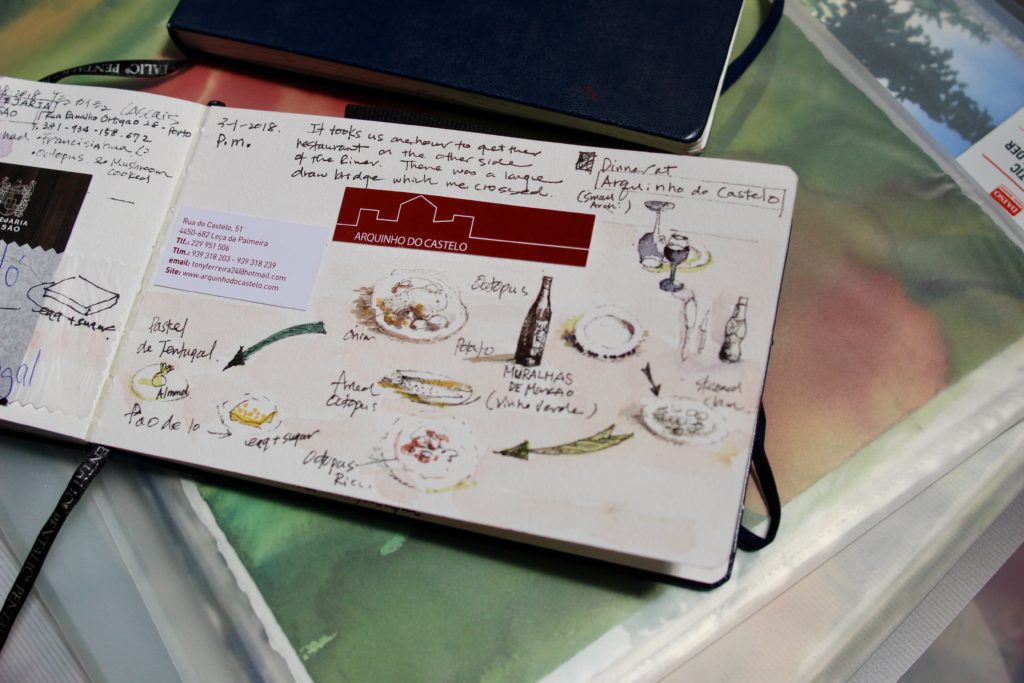
Satoko Motouji’s stacks of sketchbooks offer a rich view of her travels, not only the places she visited but down to the pictorial details of meals that she ate.

